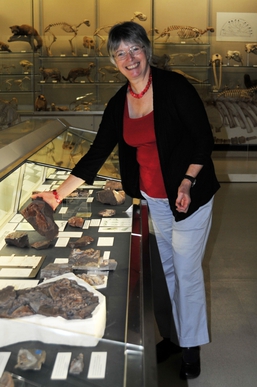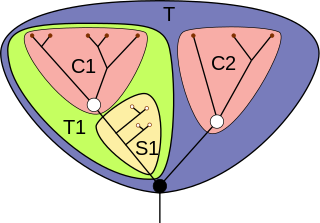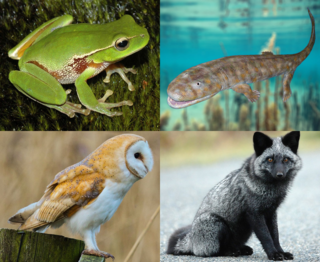
A tetrapod is any four-limbed vertebrate animal of the superclass Tetrapoda. Tetrapods include all extant and extinct amphibians and amniotes, with the latter in turn evolving into two major clades, the sauropsids and synapsids. Some tetrapods such as snakes, legless lizards, and caecilians had evolved to become limbless via mutations of the Hox gene, although some do still have a pair of vestigial spurs that are remnants of the hindlimbs.

Jennifer Alice Clack, was an English palaeontologist and evolutionary biologist. She specialised in the early evolution of tetrapods, specifically studying the "fish to tetrapod" transition: the origin, evolutionary development and radiation of early tetrapods and their relatives among the lobe-finned fishes. She is best known for her book Gaining Ground: the Origin and Early Evolution of Tetrapods, published in 2002 and written with the layperson in mind.

In phylogenetics, the crown group or crown assemblage is a collection of species composed of the living representatives of the collection, the most recent common ancestor of the collection, and all descendants of the most recent common ancestor. It is thus a way of defining a clade, a group consisting of a species and all its extant or extinct descendants. For example, Neornithes (birds) can be defined as a crown group, which includes the most recent common ancestor of all modern birds, and all of its extant or extinct descendants.
Romer's gap is an example of an apparent gap in the tetrapod fossil record used in the study of evolutionary biology. Such gaps represent periods from which excavators have not yet found relevant fossils. Romer's gap is named after paleontologist Alfred Romer, who first recognised it in 1956. Recent discoveries in Scotland are beginning to close this gap in palaeontological knowledge.

Casineria is an extinct genus of tetrapod which lived about 340-334 million years ago in the Mississippian epoch of the Carboniferous period. Its generic name, Casineria, is a latinization of Cheese Bay. The site near Edinburgh, Scotland where the holotype fossil was found. When originally described in 1999, it was identified as a transitional fossil noted for its mix of basal (amphibian-like) and advanced (reptile-like) characteristics, putting it at or very near the origin of the amniotes, the group containing all mammals, birds, modern reptiles, and other descendants of their reptile-like common ancestor. However, the sole known fossil is lacking key elements such as a skull, making exact analysis difficult. As a result, the classification of Casineria has been more controversial in analyses conducted since 1999. Other proposed affinities include a placement among the lepospondyls, seymouriamorphs, "gephyrostegids", or as a synonym of Caerorhachis, another controversial tetrapod which may have been an early temnospondyl.

Ventastega is an extinct genus of stem tetrapod that lived during the Upper Fammenian of the Late Devonian, approximately 372.2 to 358.9 million years ago. Only one species is known that belongs in the genus, Ventastega curonica, which was described in 1996 after fossils were discovered in 1933 and mistakenly associated with a fish called Polyplocodus wenjukovi. ‘Curonica’ in the species name refers to Curonia, the Latin name for Kurzeme, a region in western Latvia. Ventastega curonica was discovered in two localities in Latvia, and was the first stem tetrapod described in Latvia along with being only the 4th Devonian tetrapodomorph known at the time of description. Based on the morphology of both cranial and post-cranial elements discovered, Ventastega is more primitive than other Devonian tetrapodomorphs including Acanthostega and Ichthyostega, and helps further understanding of the fish-tetrapod transition.

Eucritta is an extinct genus of stem-tetrapod from the Viséan epoch in the Carboniferous period of Scotland. The name of the type and only species, E. melanolimnetes is a homage to the 1954 horror film Creature from the Black Lagoon.
The Hangenberg event, also known as the Hangenberg crisis or end-Devonian extinction, is a mass extinction that occurred at the end of the Famennian stage, the last stage in the Devonian Period. It is usually considered the second-largest extinction in the Devonian Period, having occurred approximately 13 million years after the Late Devonian mass extinction at the Frasnian-Famennian boundary. The event is named after the Hangenberg Shale, which is part of a sequence that straddles the Devonian-Carboniferous boundary in the Rhenish Massif of Germany.

Pederpes is an extinct genus of early Carboniferous tetrapod, dating from 348 to 347.6 Ma in the Tournaisian age. Pederpes contains one species, P. finneyae, 1 m long.

Stegocephali is a clade of vertebrate animals containing all fully limbed tetrapodomorphs. It is equivalent to a broad definition of the superclass Tetrapoda: under this broad definition, the term "tetrapod" applies to any animal descended from the first vertebrate with four limbs each with five digits in the extremity (pentadactyly), rather than fins of their sarcopterygian relatives.

Orobates is an extinct genus of diadectid reptiliomorphs that lived during the Early Permian. Its fossilised remains were found in Germany. A combination of primitive and derived traits distinguish it from all other well-known members of Diadectidae, a family of herbivorous reptiliomorphs. It weighed about 4 kg and appears to have been part of an upland fauna, browsing on high fibre plants.

Occidens is an extinct genus of stem tetrapod from the Early Carboniferous (Tournaisian) Altagoan Formation of Northern Ireland. It is known from a single type species, Occidens portlocki, named in 2004 on the basis of a left lower jaw described by British geologist Joseph Ellison Portlock in 1843.

The Ballagan Formation is a geologic formation in Scotland and England. It preserves fossils dating back to the early part of the Carboniferous period. Its name comes from the "Ballagan Beds" of Ballagan Glen, near Strathblane, which has a good example of this geological formation.
The arthropod gap is an apparent gap in the arthropod fossil record used in the study of evolutionary biology. It still occurs in the early Carboniferous, coinciding and extending past the Romer's gap for tetrapods, who were newly arriving on land.
Aytonerpeton is an extinct genus of stem-tetrapod from the Ballagan Formation of Scotland. It was one of five new genera of early limbed vertebrates from the Ballagan Formation described by Clack et al. in 2016. These vertebrates were among the only known in the world from a period of time known as Romer's gap. Romer's gap, which spans most of the Mississippian age of the Carboniferous, is characterized by a comparative rarity of tetrapod and stem-tetrapod fossils compared to the periods of time directly older and younger than it. However, Aytonerpeton and other Ballagan stem-tetrapods help to close in this gap in the vertebrate fossil record.
This list of fossil amphibians described in 2018 is a list of new taxa of fossil amphibians that were described during the year 2018, as well as other significant discoveries and events related to amphibian paleontology that occurred in 2018.
Diploradus is an extinct genus of four-limbed stem-tetrapod from the Mississippian (mid-Tournaisian) of Scotland. It contains a single species, Diploradus austiumensis, based on an incomplete skull and jaw fragments from the Ballagan Formation at Burnmouth. The most complete part of the specimen, the lower jaw, was about 3.0 cm in length and possessed several rows of small, numerous teeth. It likely represents a juvenile animal. Diploradus was described in a 2016 study which was devised to fill in the tetrapod and stem-tetrapod faunas of Romer's gap, an interval of the early Carboniferous with few vertebrate fossils. It was one of five new genera named in this study, along with Aytonerpeton, Koilops, Ossirarus, and Perittodus.
Koilops is an extinct genus of four-limbed stem-tetrapod from the Mississippian (mid-Tournaisian) of Scotland. It contains a single species, Koilops herma, based on a mold of an 8.0 cm -long skull from the Ballagan Formation. A phylogenetic analysis in its original description places Koilops as a close relative of Tulerpeton and colosteids. Koilops was described in a 2016 study which was devised to fill in the tetrapod and stem-tetrapod faunas of Romer's gap, an interval of the early Carboniferous with few vertebrate fossils. It was one of five new genera named in this study, along with Aytonerpeton, Diploradus, Ossirarus, and Perittodus.
Ossirarus is an extinct genus of four-limbed stem-tetrapod from the Mississippian (mid-Tournaisian) of Scotland. It contains a single species, Ossirarus kierani, based on disarticulated skull and postcranial bones from the Ballagan Formation at Burnmouth. It would have had a large, pointed tabular horn and several minor traits shared with Devonian stem-tetrapods. Ossirarus was described in a 2016 study which was devised to fill in the tetrapod and stem-tetrapod faunas of Romer's gap, an interval of the early Carboniferous with few vertebrate fossils. It was one of five new genera named in this study, along with Aytonerpeton, Diploradus, Koilops, and Perittodus.
Mesanerpeton is an extinct genus of four-limbed stem-tetrapod from the Mississippian (Tournaisian) of Scotland. It contains a single species, Mesanerpeton woodi, who based on a disarticulated specimen including a clavicle, vertebrae, and forelimb bones from the Ballagan Formation. The vertebrae are poorly-ossified and similar to Crassigyrinus, but the forelimb was robust. The shape and level of torsion present in the humerus are intermediate between Devonian stem-tetrapods and later Carboniferous tetrapods. This transitional condition, and the associated rerouting of the brachial artery and median nerve, may indicate that Mesanerpeton had a higher stride length and more efficient locomotion on land compared to its predecessors.

















